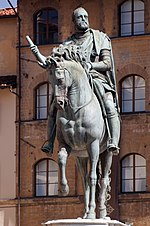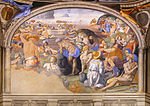Fountain of Neptune, Florence

The Fountain of Neptune in Florence, Italy, (Italian: Fontana del Nettuno) is situated in the Piazza della Signoria (Signoria square), in front of the Palazzo Vecchio. The fountain was commissioned by Cosimo I de' Medici in 1559 to celebrate the marriage of Francesco de' Medici I to Grand Duchess Joanna of Austria. Cosimo I de' Medici was the Duke of Florence from 1537-1569 and responsible for a vast number of architectural and artistic elements in Florence that still exist today. The fountain was designed by Baccio Bandinelli, but created by Bartolomeo Ammannati with the assistance of several other artists between 1560 and 1574. It incorporates a series of mythological figures and iconographies that symbolize both Cosimo I de' Medici's power and the union of Francesco and Joanna. It has sustained a great deal of damage over the years due to vandalism and general mistreatment but underwent a major restoration completed in 2019 that restored it to its original glory.
Excerpt from the Wikipedia article Fountain of Neptune, Florence (License: CC BY-SA 3.0, Authors, Images).Fountain of Neptune, Florence
Calimaruzza, Florence Quartiere 1
Geographical coordinates (GPS) Address Nearby Places Show on map
Geographical coordinates (GPS)
| Latitude | Longitude |
|---|---|
| N 43.769577777778 ° | E 11.256075 ° |
Address
Piazza della Signoria
Calimaruzza
50122 Florence, Quartiere 1
Tuscany, Italy
Open on Google Maps











